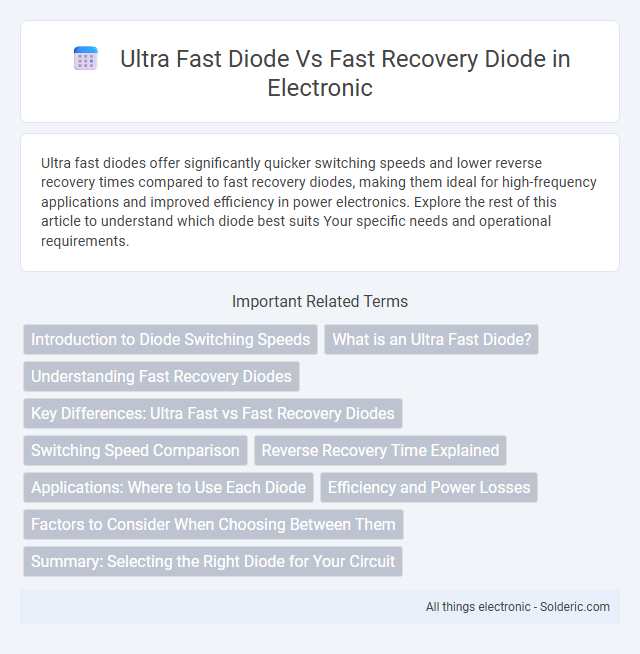Ultra fast diodes offer significantly quicker switching speeds and lower reverse recovery times compared to fast recovery diodes, making them ideal for high-frequency applications and improved efficiency in power electronics. Explore the rest of this article to understand which diode best suits Your specific needs and operational requirements.
Comparison Table
| Feature | Ultra Fast Diode | Fast Recovery Diode |
|---|---|---|
| Recovery Time | Typically <= 50 ns | Typically 100 ns to 500 ns |
| Switching Speed | Extremely fast switching | Moderate switching speed |
| Applications | High-frequency circuits, SMPS, inverters | Rectification in power supplies, motor controls |
| Forward Voltage Drop (VF) | Typically 0.7V - 1.1V | Typically 0.7V - 1.0V |
| Reverse Recovery Charge (QRR) | Low QRR | Higher QRR than ultra fast diodes |
| Cost | Higher due to advanced material and design | Lower, more economical |
| Typical Devices | 1N4148, Schottky alternatives in high speed | 1N4937, 1N1184R |
Introduction to Diode Switching Speeds
Ultra fast diodes switch from conducting to non-conducting states significantly faster than fast recovery diodes, with recovery times often below 100 nanoseconds compared to hundreds of nanoseconds in fast recovery diodes. This rapid switching speed reduces switching losses and electromagnetic interference in high-frequency applications such as power supplies and inverters. Selecting the appropriate diode based on your circuit's switching speed requirements ensures optimal performance and efficiency.
What is an Ultra Fast Diode?
An Ultra Fast Diode is a semiconductor device designed for high-speed switching with reverse recovery times typically below 50 nanoseconds, enabling efficient operation in high-frequency circuits. It features minimal reverse recovery charge and low forward voltage drop, making it ideal for applications in switch-mode power supplies and high-frequency inverters. Compared to Fast Recovery Diodes, Ultra Fast Diodes offer superior switching performance and reduced electromagnetic interference in advanced electronic systems.
Understanding Fast Recovery Diodes
Fast recovery diodes are designed to efficiently switch off their current quickly, reducing switching losses and improving performance in high-frequency applications compared to standard diodes. Unlike ultra fast diodes that prioritize ultra-low recovery time for extremely fast switching, fast recovery diodes balance speed and cost-effectiveness with recovery times typically in the microsecond range. Choosing the right diode depends on your circuit's switching frequency and power requirements, making fast recovery diodes a suitable choice for many power electronics scenarios.
Key Differences: Ultra Fast vs Fast Recovery Diodes
Ultra fast diodes exhibit switching times typically below 50 nanoseconds, making them ideal for high-frequency applications, whereas fast recovery diodes have recovery times in the range of 50 to 200 nanoseconds, suitable for moderate switching speeds. The ultra fast diode offers lower reverse recovery charge (Qrr) and minimal switching losses, enhancing efficiency in power converters and RF circuits compared to fast recovery diodes. Ultra fast diodes also demonstrate superior performance in reducing electromagnetic interference (EMI) and thermal dissipation during high-speed switching processes.
Switching Speed Comparison
Ultra fast diodes exhibit switching speeds typically in the range of nanoseconds, significantly faster than fast recovery diodes, which usually have switching times in the microsecond range. This rapid switching performance makes ultra fast diodes ideal for high-frequency applications such as switching power supplies and RF circuits. Your choice between these diodes should consider the specific switching speed requirements to optimize circuit efficiency and minimize power loss.
Reverse Recovery Time Explained
Ultra fast diodes exhibit a significantly shorter reverse recovery time, typically in the range of a few nanoseconds, compared to fast recovery diodes which have reverse recovery times from tens to hundreds of nanoseconds. This rapid reverse recovery time reduces switching losses and electromagnetic interference, making ultra fast diodes ideal for high-frequency applications such as switching power supplies and inverters. Fast recovery diodes, while slower, offer a good balance between speed and voltage rating, suitable for medium-speed switching circuits where some reverse recovery charge is acceptable.
Applications: Where to Use Each Diode
Ultra fast diodes are ideal for high-frequency switching applications such as switch-mode power supplies, inverters, and RF circuits due to their extremely short reverse recovery times, which minimize switching losses. Fast recovery diodes are better suited for medium-frequency applications like power rectification in motor drives and power converters where moderate recovery speed reduces electromagnetic interference without the need for ultra-low switching losses. Selecting between ultra fast and fast recovery diodes depends on the trade-off between switching speed requirements and cost constraints in electronic designs.
Efficiency and Power Losses
Ultra fast diodes demonstrate higher efficiency compared to fast recovery diodes due to their reduced reverse recovery time, which minimizes switching losses in high-frequency applications. Fast recovery diodes, while still effective, exhibit greater power losses because of longer tail current during switching transitions, leading to increased heat dissipation. Choosing an ultra fast diode for your circuits can significantly enhance performance by lowering power losses and improving overall system efficiency.
Factors to Consider When Choosing Between Them
When choosing between an ultra fast diode and a fast recovery diode, consider switching speed, reverse recovery time, and voltage ratings to match your circuit demands accurately. Ultra fast diodes offer lower reverse recovery times, making them ideal for high-frequency applications, while fast recovery diodes balance speed and power handling for moderately fast switching. Your specific application needs, including efficiency, thermal performance, and cost constraints, should guide the choice for optimal electrical performance.
Summary: Selecting the Right Diode for Your Circuit
Ultra fast diodes offer switching speeds in the nanosecond range, making them ideal for high-frequency applications requiring minimal switching loss. Fast recovery diodes have slower recovery times but are better suited for circuits where voltage spikes and noise must be controlled during switching. Choosing the right diode depends on balancing your circuit's speed requirements against factors like efficiency, voltage ratings, and noise tolerance.
Ultra fast diode vs fast recovery diode Infographic

 solderic.com
solderic.com